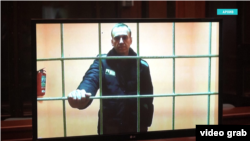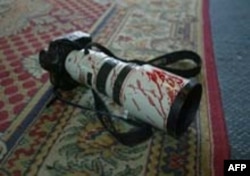Iranian authorities have prevented the commemoration of victims of a bloody crackdown on antigovernment protests in November 2019 as the third anniversary of the events coincided with nationwide protests triggered by the death of a 22-year-old woman in September after she was detained by Iran's morality police.
Relatives of two people who were shot and killed during the November 2019 protest -- Pejman Gholipur, 18, and Pouya Bakhtiari, 27 -- were arrested ahead of the commemoration, according to reports from Iran.
Gholipur’s parents as well as his brother were arrested in Gilan on November 17, according to the opposition activist collective 1500tasvir. Security agents also seized their mobile phones and published a message on Instagram about the cancellation of the commemoration for Gholipur.
Bakhtiari's sister said security agents cut off Internet access for all Bakhtiari family members and locked them in their house to prevent them from attending the commemoration for their relative.
Gholipur and Bakhtiari were among hundreds of demonstrators who were killed during the 2019 protests, which were triggered by a sudden rise in the price of gasoline.
Gholipur and Bakhtiari had joined the protests that spread to more than 100 Iranian cities and towns and lasted for days. The protests quickly turned political, with many chanting against the Iranian clerical establishment and its leaders.
An estimated 1,500 people were killed by security forces, according to Reuters. The majority of the protests lasted four days; however, spillover clashes lasted until July 2020.
Widespread strikes continued on November 17 elsewhere in Iran, including in the cities of Sari, Sanandaj, Zarghan, and others, according to videos received by RFE/RL's Radio Farda.
It was the third consecutive day of strikes by shopkeepers and businesses despite a widening crackdown as protests that flared over Mahsa Amini’s death entered a third month. Amini died after she was taken into custody by morality police allegedly for improperly wearing a head scarf, or hijab. Her family and supporters say she was severely beaten. Iranian authorities have blamed her death on "underlying diseases."
In videos from the northeastern Iranian city of Mashhad, security agents try to force shopkeepers who have closed their shops in protest to reopen. In one of these videos, officers are seen throwing tear gas at protesters.
The videos published on social media from the Iranian Kurdish city of Bukan show the large presence of people in the streets and intense clashes with security agents.
It was not possible to verify the authenticity of the videos, which have been widely distributed on social media.
The Norway-based Hengaw rights group reported a massive protest in western Iranian city of Sanandaj on November 16. The organization confirmed the death of at least two protestors in the Kurdish city.
The protests, which are demanding more freedoms and women's rights, pose the biggest threat to the Islamic government since the 1979 revolution.
Authorities have met the unrest with a harsh crackdown that the Oslo-based group Iran Human Rights says has killed at least 300 people, including 40 children.
Written by Ardeshir Tayebi based on an original story in Persian by RFE/RL's Radio Farda



